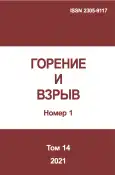Local velocities of hot-spot combustion front in HMX
- 作者: Marshakov V.N.1, Melik-Gaykazov G.V.1
-
隶属关系:
- Semenov Federal Research Center for Chemical Physics of the Russian Academy of Sciences
- 期: 卷 14, 编号 1 (2021)
- 页面: 59-67
- 栏目: Articles
- URL: https://journals.rcsi.science/2305-9117/article/view/286570
- DOI: https://doi.org/10.30826/CE21140107
- ID: 286570
如何引用文章
详细
The mechanism of HMX combustion at pressures of 0.05–5.0 MPa is investigated. Itis shown that HMX burns in the focal (hot-spot) mode. In the article “HMX combustion mechanism” byV. N. Marshakov, V. G. Krupkin, and S. A. Rashkovsky (2020. Russ. J. Phys. Chem. B 14(6):934–939. doi: 10.1134/S1990793120060111), the scale of inhomogeneity of the combustion surface — the characteristic size of hot spots is determined. The dependence of the size of the hot spots on the average burning rate of the sample is obtained. In the present article, the temperature distributions in the combustion wave obtained using thermocouples are analyzed. The local burning rates are obtained from the analysis of temperature distributions in the condensed phase (close to the Mikchelson distribution). It is shown that the scatter of the burning rate values is explained by the registration of the velocity at different points of the transverse wave front. The values of the local burning rates exceeding the average burning rate are caused by the elevated initial temperature of the sample ahead of the flame front and the smaller values are explained by the curvature of the flame front and by the buckling mode of combustion.
作者简介
Vladimir Marshakov
Semenov Federal Research Center for Chemical Physics of the Russian Academy of Sciences
编辑信件的主要联系方式.
Email: marsh_35@mail.ru
Doctor of Science in Physics and Mathematics, Chief Researcher
俄罗斯联邦, 4, Kosygin St., Moscow, 119991Georgy Melik-Gaykazov
Semenov Federal Research Center for Chemical Physics of the Russian Academy of Sciences
Email: marsh@chph.ras.ru
Candidate of Science in Physics and Mathematics, Senior Engineer
俄罗斯联邦, 4, Kosygin St., Moscow, 119991参考
- Puchkov, V. M. 1978. Struktura zon goreniya TRT v statsionarnykh rezhimakh i pri pogasanii [The structure of the combustion zones of SRP in the stationary modes and with the extinction]. Moscow: IChF AN SSSR. PhD Diss. 211 p.
- Price, C. F., T. L. Boggs, and R. L. Derr. 1979. The steadystate combustion behavior of ammonium perchlorate and HMX. AIAA Paper No. 79-0164. 14p.
- Shchemelin, Yu. A., and S. B. Umblia. 1983. Experimental’noe issledovanie mekhanizma goreniya oktogena [Experimental study of the mechanism of octogen combustion]. Voprosy vosplameneniya i goreniya raketnykh topliv [Problems of ignition and combustion of rocket fuels]. Tomsk: TGU. 105–111.
- Korobeinichev, O. P., L.V. Kuibida, and V. Zh. Hadirbaev. 1984. Investigation of the chemical structure of the HMX flame. Combust. Explo. Shock Waves 20(3):282–285.
- Glazkova, A. P., G. T. Aphanasyev, and S. I. Postnov. 1991. Deflagration and high-temperature ignition of RDX and HMX. 2nd Beijing Symposium (International) on Pyrotechnics and Explosive combined with 17th Pyrotechnics Seminar (International). Beijing, People’s Repablic of China. 1:636.
- Kubota, N. 1992. Flame structure of modern solid propellants. Nonsteady burning and combustion stability of solid propellants. Eds. L. De Luca, E. W. Price, and M. Summerfield. Progress in astronautics and aeronautics ser. Washington, D.C.: AIAA. 143:233–259.
- Zenin, A. A. 1995. HMX and RDX. Combustion mechanism and influence on modern double-base propellant combustion. J. Propul. Power 11(4):752–758.
- Simonenko, V. N., A. B. Kiskin, V. E. Zarko, and A. G. Svit. 1997. Specific features of nitramine combustion at atmospheric pressure. Combust. Explo. Shock Waves 33(6):685–687.
- Zenin, A. A., V. M. Puchkov, and S. V. Finyakov. 1998. Characteristics of HMX combustion waves at various pressures and initial temperatures. Combust. Explo. Shock Waves 34(2):170–176.
- Atwood, A. L., T. L. Boggs, P. O. Curran, and D. M. Hanson-Parr. 1999. Burning rate of solid propellant ingredients, part 1: Pressure and initial temperature effects. J. Propul. Power 15(6):740–742.
- Zenin, A. A., and S.V. Finjakov. 2006. Characteristics of octogen and hexogen combustion: A comparison. Prog. 37th Annual Conference (International) of ICT. Karlsruhe. Paper 118. 18 p.
- Sinditskii, V. P., V. Yu. Egorshev, M. V. Berezin, and V. V. Serushkin. 2009. Mechanism of HMX combustion in a wide range of pressures. Combust. Explo. Shock Waves 45(4):461–477.
- Marshakov, V. N., V. G. Krupkin, and S. A. Rashkovsky. 2020. HMX Combustion Mechanism. Russ. J. Phys. Chem. B 14(6):934–939. doi: 10.1134/ S1990793120060111.
- Zel’dovich, Ya. B. 1942. K teorii goreniya porokhov i vzryvchatykh veshchestv [On the theory of combustion of gunpowder and explosives]. JETF 12(11-12):498–524.
- Novozhilov, B. V. 1973. Nestatsionarnoe gorenie tverdykh raketnykh topliv [Nonstationary combustion of solid rocket propellants]. Moscow: Nauka. 176 p.
- Kondrikov, B. N., and B. V. Novozhilov. 1974. Critical combustion diameter of condensed substances. Combust. Explo. Shock Waves 10(5):580–587.
- Romanov, O. Ya. 2007. Critical combustion diameter. Combust. Explo. Shock Waves 43(1):25–33.
- Rashkovskiy, S.А. 2011. Effect of the curvature of the burning surface of condensed energetic materials on the burning rate. Combust. Explo. Shock Waves 47(6):687– 696. doi: 10.1134/s0010508211060104.
补充文件









